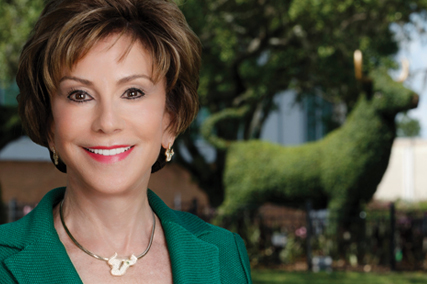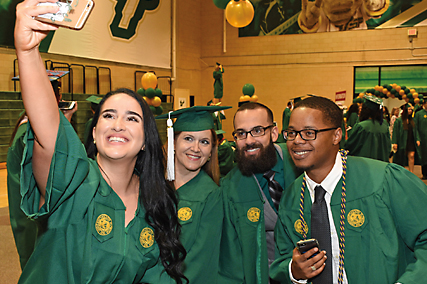Current Features
Start of a New Era
The University of South Florida is the state's newest Preeminent University – a major milestone in a transformative journey that's just beginning.
By Aaron Hilf

"What ought to be, can be, with the will to make it so."
– James Rouse, Visionary Developer & Urban Planner
Nearly 20 years ago, newly selected USF System President Judy Genshaft spoke those words to a crowd gathered for her inauguration ceremony. The quote was more than just inspirational rhetoric for USF's sixth leader – it was a call to action that has guided and galvanized the university ever since.
USF, at just 62 years old, is in some ways still in its formative stages as a major research university. But, while it continues to build on its not-so-distant past, it has also been able to look to the future while achieving something that many may not have thought possible.
"Thanks to the unwavering support of our community and the hard work of so many individuals across our campus, USF is now a Preeminent State Research University, standing among the most elite institutions in our state," Genshaft said in a message to the community announcing the Preeminence achievement in June. "This designation validates our efforts over more than a decade to transform USF into a premiere institution of higher education."
As Florida's newest Preeminent University, USF joins the ranks of just two other Florida public institutions with this prestigious designation – both of which were founded more than 100 years before USF. Formally approved by the State University System of Florida Board of Governors, the title is the culmination of years of hard work and focus by the USF community to make the university a national leader in student success, research and community engagement.
The designation also marks a significant milestone for the university that unites faculty, staff, students, alumni, supporters and the entire Tampa Bay region around a common point of pride.
"Achieving Preeminence is a testament to USF's longstanding commitment to student success, world-class research and faculty excellence," says Brian Lamb, USF Board of Trustees chair. "Preeminence positions the university to compete for the very best talent nationally and globally, which accelerates the growing reputation of the university and the Tampa Bay community."
Adopted by the Florida Legislature in 2013, the Preeminent State Research Universities Program rewards high-performing state research institutions based on 12 outcome measures, including graduation rates, student retention rates and research expenditures, among others.
In 2016, USF became Florida's first Emerging Preeminent State Research University after meeting nine of the 12 requirements. Since that time, USF has continued to blaze its own path forward, building on its six-year graduation rate and student retention rates to qualify for full Preeminence.
Today, USF meets 11 of the 12 required metrics, the threshold for the designation. The university continues to work to meet the final metric, a $500 million endowment fund. And with more than $480 million in its current endowment, USF officials are confident they'll fulfill all 12 metrics soon.
The amount of funding awarded to Preeminent institutions is determined each year by the state Legislature and governor. The funding is distributed among all Preeminent and Emerging Preeminent institutions, with Emerging Preeminent universities receiving a smaller percentage of the whole. Since 2013, the Legislature has set aside nearly $152 million in additional funding for Preeminent and Emerging Preeminent institutions. This year, USF received more than $6.1 million in recurring funds, along with the University of Florida and Florida State University, the two other Preeminent institutions. The University of Central Florida, an Emerging Preeminent institution, received $1.5 million.
USF's new dollars will be used to build on existing student success initiatives, attract nationally prominent faculty members and enhance research activities in strategic areas, such as heart health and medical engineering. Those two fields are critically important as USF moves forward with plans to open the new USF Health Morsani College of Medicine and Heart Institute facility in late 2019 as part of downtown's $3 billion development project, Water Street Tampa.
Nevertheless, it's not necessarily the financial awards that matter most.
Says Genshaft: "We are excited by the prospect of new resources that we can use to
further drive success for our students. But, our real reward is in the spirit of creativity,
collaboration and dedication that has resulted from this drive toward Preeminence."
For more than a decade, USF has maintained its vision of transforming into a nationally recognized research institution – capable of changing the world through innovation and the lives of students through education.
In 2009, years before the Preeminence statute was developed, USF launched a Student Success Task Force designed to improve many of the student success metrics lawmakers would later include in the program. At the time, USF's six-year graduation rate was 48 percent. Now, thanks to efforts across campus, including the use of real-time predictive analytics that help track students' academic progress, the rate stands at more than 70 percent. The dramatic improvement came while also eliminating the achievement gap between students based on race, ethnicity and economic status – an effort recognized by the Washington D.C.-based publication, Education Dive, which named USF its 2017 Institution of the Year.
USF's research presence has also surged. In 2000, the university's annual research expenditures were roughly $100 million. Today, as one of the nation's top 30 public universities for research productivity, USF uses more than $500 million a year in grant funding to produce better treatments for diseases, craft new technologies and boost the regional economy. In fact, it's estimated that USF's 2017 research funding supported nearly 6,000 jobs and generated over $1 billion in economic growth across the Tampa Bay region.
While these remarkable transformations, along with many others, have helped position the university to achieve its Preeminent status, university leaders say the designation is simply a side effect of a much greater mission – to turn USF into the best version of itself possible, never settling and always striving for more. It's an effort that shows no signs of slowing down.
"While we celebrate being recognized as Preeminent by our state leaders, this is not the end of our journey. It is a new beginning," Genshaft says. "We will continue our quest to move up in national higher education rankings so that we can attract even more of the best and brightest students and world-class scholars and researchers."
The journey to Preeminence: transforming a bold vision into a Bullish achievement

2000 - PRESENT
Dr. Judy Genshaft becomes USF's sixth president
USF's new president, Dr. Judy Genshaft, shares her vision of USF as a prominent national
research university. In her inaugural address, she says: "We dream of being one of
the preeminent universities. To get there, it is our responsibility to constantly
ask two questions of ourselves. First: In each of our programs, are we setting the
national standard for others? Second: If not, what will it take for us to do so?"

2009 – Student Success Task Force Formed
In November 2009, President Genshaft and provost and executive vice president Ralph
Wilcox convene a 100-person Student Success Task Force to build upon and accelerate
a campus-wide initiative to maximize student success without compromising USF's commitment
to access and diversity. The Task Force's report, submitted in April 2010, provided
the blueprint for the Student Success movement, which contributed to record gains
in student retention and graduation rates.
2013 – Preeminence signed into law
On April 22, 2013, a bill to elevate the national stature of Florida's public universities
is signed into law by Gov. Rick Scott. The new law confers Preeminent status to a
university if it achieves at least 11 of 12 benchmarks, the state's "academic and
research excellence standards."
2016 – Emerging Preeminent status achieved
Florida lawmakers amend the law, establishing a new designation of Emerging Preeminent
State Research University for universities that meet at least six of the 12 Preeminence
benchmarks. USF is designated the state's first Emerging Preeminent university by
the Florida Board of Governors in June 2016, having met nine of the 12 Preeminence
benchmarks. President Genshaft sets the goal for USF to achieve full Preeminence in
just two years, by 2018.

2018 – USF reaches Preeminence
On June 28, 2018, the Board of Governors of the State University System certifies
that USF has met the necessary thresholds and the board officially designates USF
as the state's third Preeminent State Research University. It is a significant milestone
in USF's mission to deliver competitive undergraduate, graduate, and professional
programs, to generate knowledge, foster intellectual development, and ensure student
success in a global environment.
Shattering the Status Quo: USF has successfully reached 11 of 12 benchmarks set by the Florida Board of Governors
71% six-year graduation rate | 25-point increase from 2000 to 2018
60 % four-year graduation rate | 40-point increase from 2000 to 2018
$502 million annual expenditures on research and development | 402% increase from 2000 to 2018
4.1 average incoming GPA | 2.5% increase 2013-14 vs. 2016-17
324 Utility patents awarded | 20% increase from 2011-13 to 2015-17
721 Doctoral degrees awarded annually | 61% increase from 2012-13 to 2016-17
300 Post doctoral appointees | 2.4% increase from fall 2010 to fall 2014
$442 million endowment | $78 million increase from 2012-13 to 2016-17
13 faculty members of national academy | 116.6% increase from 2014 to 2018
$288 million spent on non-medical science and engineering research | $95 million increase from 2012-13 to 2016-17
7 of 8 broad disciplines ranked in top 100 for research expenditures | 87.5% increase from 2011-12 to 2015-16
4 public university national rankings | 400% increase 2014 to 2018
90% freshman retention rate | 1% increase 2012-13 to 2016-17
1280 average SAT score | 80 pt. increase from 2013 to 2017